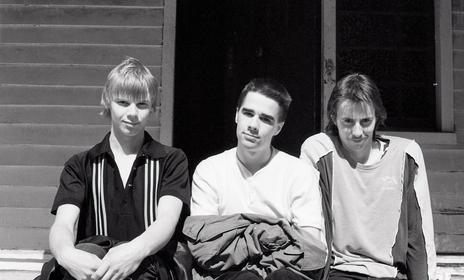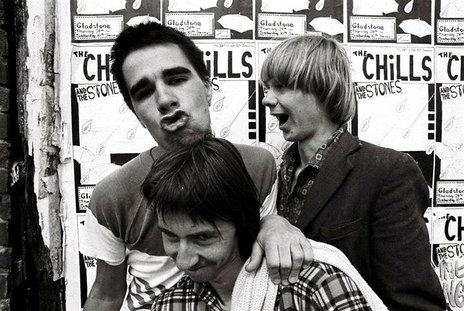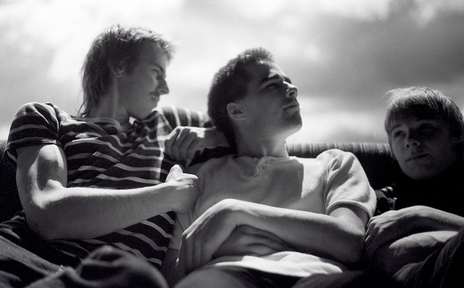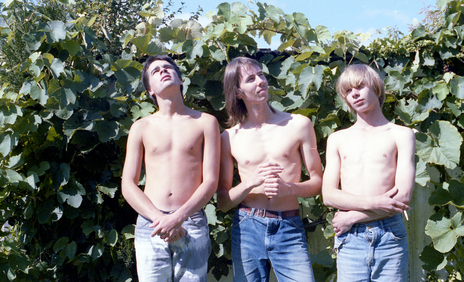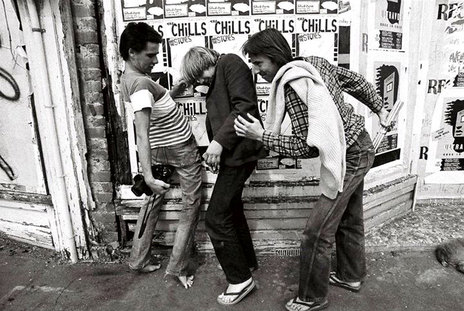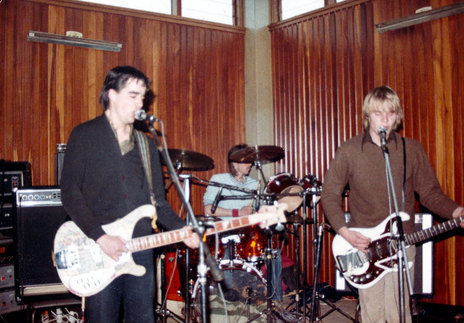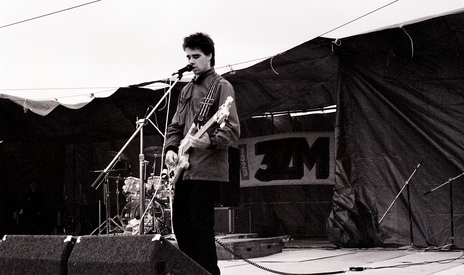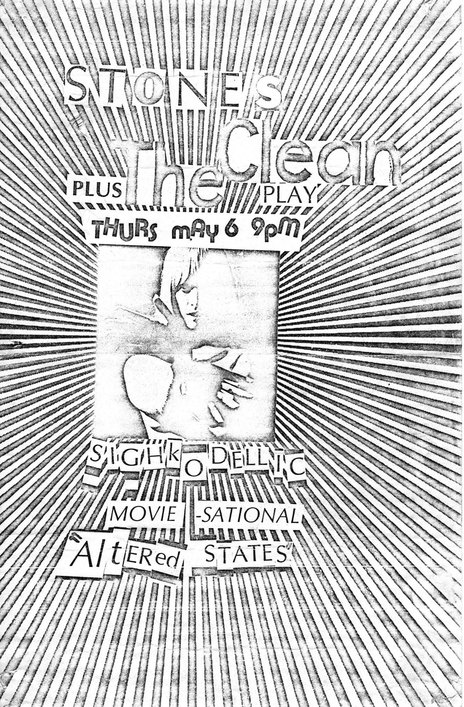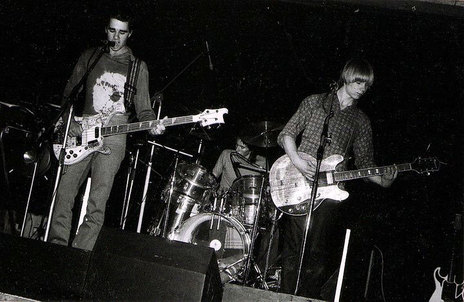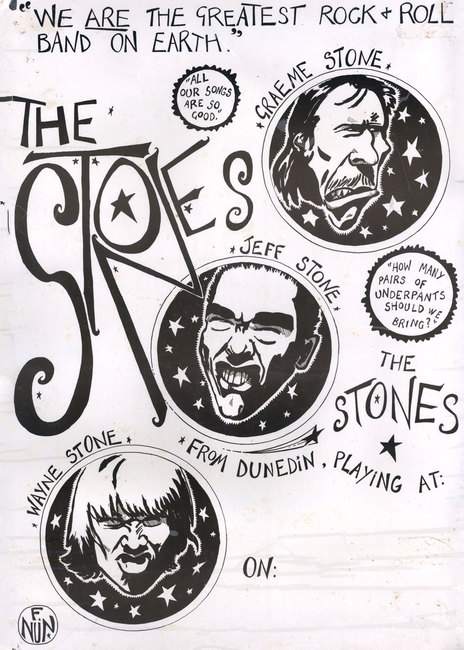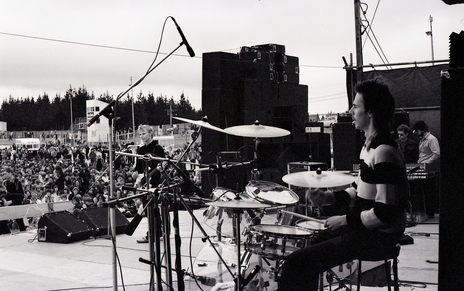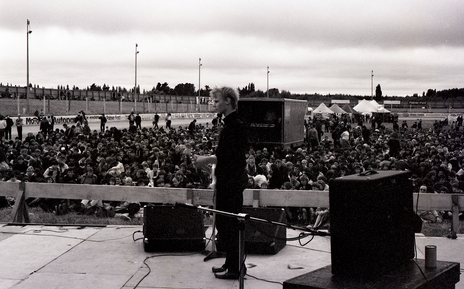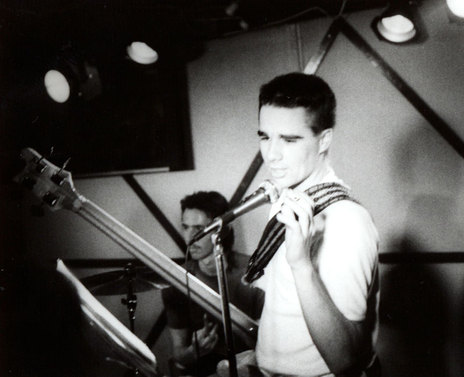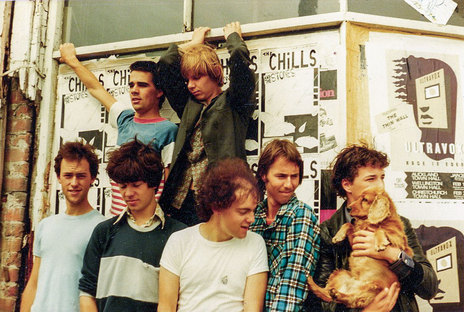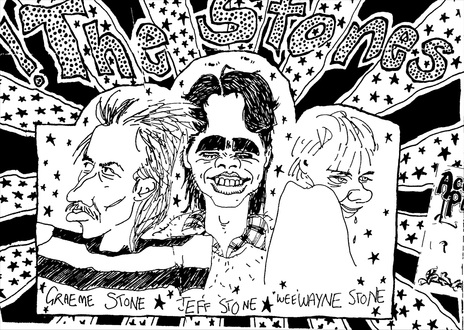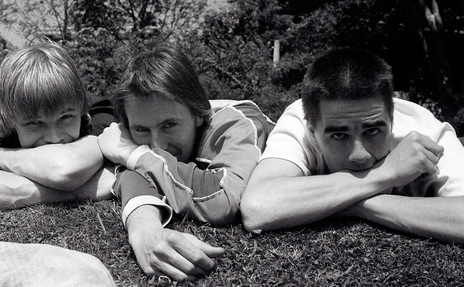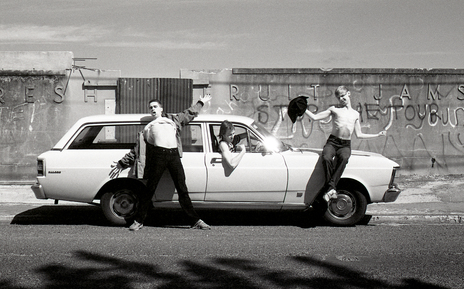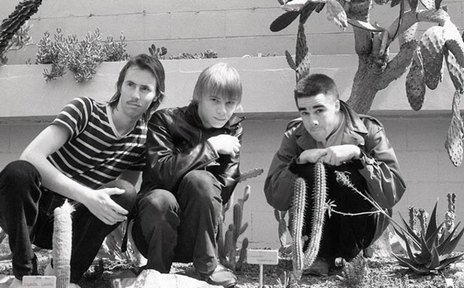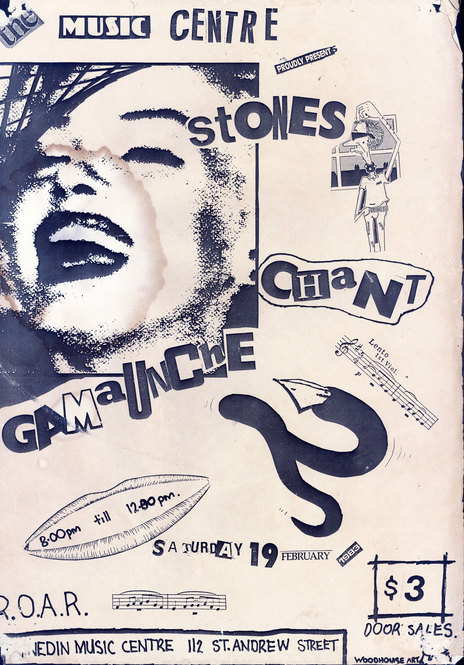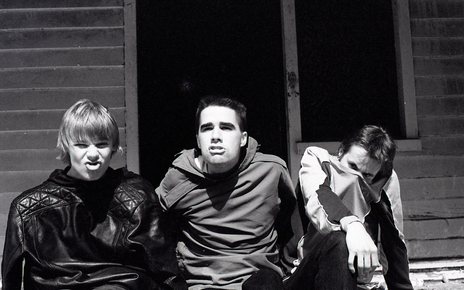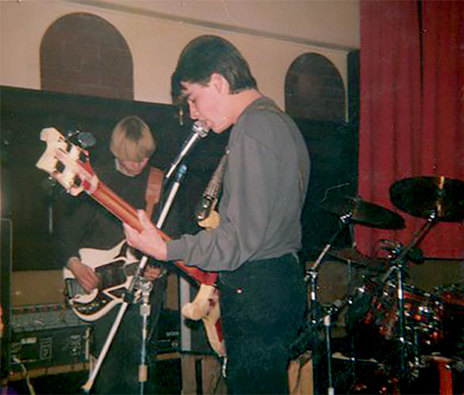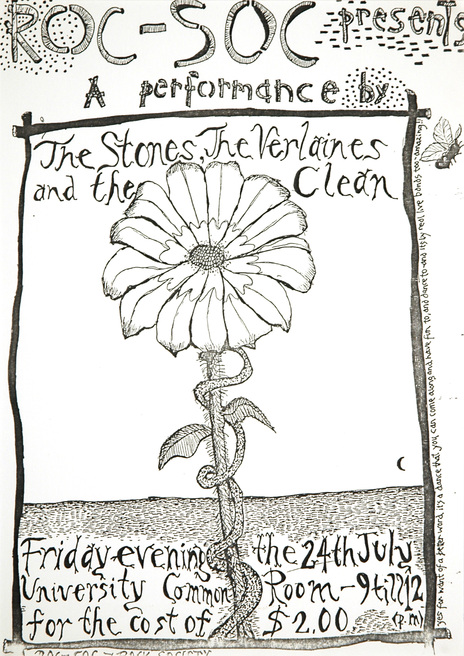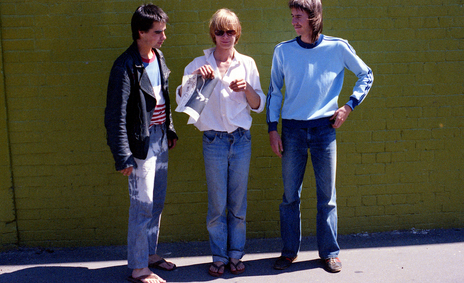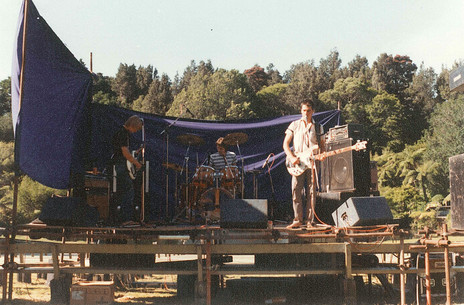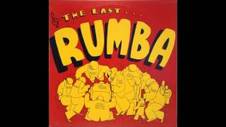Five months earlier in December 1982, bass player and vocalist Jeff Batts “apologised” onstage to New Order’s Wellington audience for “not wearing the right clothes”.
In 1983, they’d tell Michael Higgins in Rip It Up that The Clean were the best band in the world – “Our ambition is to have them support us.”
Every music scene needs someone like The Stones – Wayne Elsey (guitar, vocals), Jeff Batts (bass, vocals) and Graeme Anderson (drums, organ) – the abrasive, short-lived Dunedin trio, who are the least known of the city’s early 1980s indie groups. A band both of and outside the community, who ruffle feathers, and in doing so, lay down overt challenges to those around them, bringing any developing status quo into stark relief. Perhaps that’s why the group has slipped so easily into the background of one of New Zealand music’s most oft-told tales.
In literary journal Landfall in 2011, The Rip’s Alastair Galbraith remembered Jeff Batts mostly for his demeanour – “Jeff Batts, Lucifer of my teenage world, calmly pouring brilliant scorn and deadpan sarcasm,” he wrote, nailing the moody personality, a telling piece of the Stones puzzle.
In the same story, Galbraith considered Elsey a more complex being – “Lean, kind, disillusioned shoulders, a wry head tilt that really listened. He said bitter things of life, looking off in other directions, and funny things with a cast-up pure gleam” – also highlighting Elsey’s benevolence in taking the young musician aside after a disappointing show to encourage him to carry on.
It’s a memory of the blond, elfin Elsey that was shared by some touring Auckland indie groups, who despite so often being pitched in opposition to the far south scene would often find a friend in Elsey.
Something New
The combative trio drew on the same pool of musicians as their southern indie contemporaries. Elsey left teen punks Bored Games looking for a group that was “more psychedelic like The Clean,” Batts was in The Same with Martin Phillipps (The Chills), and drummer Anderson was a childhood friend of Elsey’s in the working class Dunedin suburb of Brockville.
The name they chose – The Stones – was funny, provocative, taboo and a source of much conjecture. Interviewed for Radio With Pictures’ 1982 Dunedin special, Friends of the Enemy, Batts explained, “We figured we’d do everything the wrong way. You’re not supposed to call yourself The Stones, so we did.”
The Stones were also in effect The Rolling Stones to The Verlaines and The Clean’s electric Dylan, Sneaky Feelings’ Beatles and The Byrds, and The Chills’ 1960s psych-pop. A tough, tight-knit gang with a lean guitar-driven sound who embraced outsider chic and had little time for expected niceties.
It was a running joke that they’d soon return to.
Down and Around
Early live dates were sparse. In July 1981, The Stones played onstage at Otago University (which Anderson and Batts attended) with The Clean and The Verlaines. November saw them supporting Christchurch’s Playthings at Dunedin’s Empire Tavern. Then it was onto The Captain Cook with The Verlaines, The Clean, The Chills and Sneaky Feelings for a four night run. In late January 1982, the Empire hosted them and The Chills. The following week, they were in Christchurch at The Gladstone, going on before The Clean.
The raw trio recorded songs for the upcoming Dunedin Double EP, which would present the city’s new groups on rising indie Flying Nun Records.
The Stones returned to Christchurch for Orientation performances at Canterbury University in late February and Star and Garter dates in early March. While they were in the Canterbury city, the raw trio recorded songs for the upcoming Dunedin Double EP, which would present the city’s new groups on rising indie Flying Nun Records.
When the landmark record appeared on record store shelves in July 1982, it contained four songs from The Stones – ‘Something New’, ‘See Red’, ‘Down and Around’ and ‘Surf’s Up’ – all rough and ready and more rock than pop or folk.
Talking to David Taylor for Otago University student newspaper Critic’s Dunedin Scene special in late 1982 – Jeff Batts outlined the trio’s influences. On being compared to 1977 punk, he replied, “That music has great energy, everyone in the band is enthused by it. I’m more inclined to go for early Jonathan Richman. At one time I really liked Gang of Four. Wayne’s into The Fall at the moment. I’m listening to tapes of The Velvet Underground, coz my stereo’s bust.”
The Velvet Underground’s “talent of making a single riff great, that’s what we’re trying to achieve,” he added. “People down here are still up on the trends. They’re not into that though.”
“We wanted an energetic feel, like The Clean EP.”
There’s a lot of Wire in their Dunedin Double songs, especially in Jeff Batts’ bass, around which Wayne Elsey’s guitar chops and stutters, sweeps and swoons, scrubbing out a ringing Velvety riff on ‘Something New’ that’s more ‘European Son’ than ‘I’ll Be Your Mirror’ as the words mimic the verbal repetition of The Clean – “You did it, you did it, you did it, uh huh …”
‘Something New’ would become the group’s most-compiled song and its words the best summation of The Stones’ world-view. “When we started we wanted to do something radically different,” Batts said in 1982. “Our philosophy at first was to do everything the wrong way, do things you’re not supposed to.”
Surf’s Up
The sarcasm spills over on ‘Surf’s Up’, a mocking dig at surf subculture and yet another ramshackle rocker. “Surf, surf, bleach your hair, WOOW, surf’s up …” Batts sings in an exaggerated piss-taking voice, backed up by a similarly insincere deep-voiced backing chorus.
“‘Surf’s Up’ was spontaneous, it was done really quickly. Next time I’d like to do it all first time,” Batts recalled.
Speaking to bFM’s Flying Nun Extended Play in 2012, drummer Anderson credits ‘Surf’s Up’ as "a bit of a piss-take, having a go at surfies, the surfie culture was really not what we were about” with Jeff Batts adding, “we were failed surfers. When you are young, you have different crowds, there was the surfie crowd, the bodgie crowd, you were quite fearful …”
The Wayne Elsey-sung ‘Down and Around’ with its persistent circular swathes of trebly, reverberated guitar, highlights what Sneaky Feelings’ Matthew Bannister identified as “The other technical device that characterises a lot of Dunedin music – reverberation. Simply put, this is the sound you get in a large hall as opposed to sound in a sitting room. The spring reverb unit, especially used on guitar, is as much a feature of Dunedin music as slap echo was of Sun studios in Memphis. ‘Pink Frost’, ‘Point That Thing’, ‘She Speeds’, Send You, ‘Down And Around’ – they all sound as if they were recorded in a rock and roll cathedral.” Or in Dunedin’s case, developed and recorded in bare floored, high-ceilinged rooms and halls.
Exile on George Street
In 2012, Graeme Anderson credited The Stones presence on the Dunedin Double as an afterthought and Batts is dismissive of the distinctive cover he designed (it echoes the sleeve of The Rolling Stones’ Exile on Mainstreet). Like much of what he produced, it's inspired and confrontational – a well-balanced and quick to catch the eye patchwork of black and white photos, depicting the group and their mates alongside those who influenced them in Christchurch and Dunedin.
The word casual comes up often in memories of The Stones. Alastair Galbraith describes Elsey and Anderson’s musical contributions: “Wayne Elsey was a casual genius. He could summon another guitar from within his guitar with a flick … cutting sharp syncopated slices and flourishes, delineating glistening edges. Graeme Anderson, master of toms and cymbals, was sometimes invisible, just the beat striding down a spine of bass chords.” So that’s casual as in instinctual and not overly thought through, or at least appearing not to have been.
“Some of it was Jeff’s attitude," said Anderson in 2012. “I was a moody little shit,” says Batts – and some of it was that we didn’t care that much. We didn’t think that we were going to be in it for that long.”
Asked in 1982 about The Stones’ next move, Batts answered. “Resist playing as much as possible. Everyone says play the Empire, play, you’ve got to play. It’s with the release of the (Dunedin Double) EP. But we’re just not all that dedicated. We practise once a week. Wayne and Graeme are working and I’ve got a lot of varsity work. Once I finish varsity I might get serious and have a really good time.”
Route 69
Which is what ended up happening. The Stones’ live performances picked up pace and frequency from June 1982 on, when they joined The Chills, The Verlaines and Sneaky Feelings in the University of Otago’s main common room for a Dunedin Double release party. They were back at the Empire in late July with The Rip, before heading up to Christchurch for shows with Auckland post-punks This Sporting Life at the DB Gladstone in August.
After two dates with Gamaunche at the Empire in late August 1982, The Stones joined The Rip, Blue Meanies, The Chant, The Verlaines, a reformed Bored Games, The Chills and Sneaky Feelings for the Empire’s first year anniversary as a new music venue on August 31. The same month, Rip It Up announced The Stones had a 10-song tape available.
When new all-ages live room The Pitz opened at 66 Bond Street in Dunedin, it was The Stones, The Chills and The Verlaines onstage. The Stones would be back there in November with The Rip after multiple shows at the Empire and The Clean’s final farewell at the Captain Cook. Then it was up the island and on to Wellington, where they supported New Order on their first NZ tour, pausing long enough for dates at Cosgroves with Naked Spots Dance before heading to Auckland to see the busy year out.
Just before Christmas and in the middle of dates with Active Eye and This Sporting Life at Auckland University café and Tall Dwarfs and First Fifteen at Rumba Bar, The Stones recorded their first standalone EP at Progressive Studios with Terry King, Chris Knox and Doug Hood. They were in similar company for a New Year’s Eve show at New Plymouth’s Army Hall with Fetus Productions, First Fifteen, Final Solution, Nocturnal Projections, Tall Dwarfs and This Sporting Life.
Fad World
The second wave of Dunedin post-punk groups was a strong strand in a broader weave of independent activity and sound in the early to mid-1980s. That much is apparent from The Stones trajectory through the time. Now free of university study, they partnered live with Jay Clarkson’s They Were Expendable at the Star and Garter in Christchurch in January 1983 before returning in February after yet more Empire dates. In the following months they shared stages with all their Dunedin contemporaries and Christchurch’s Mainly Spaniards.
Early April found them on the South Island’s west coast at the Punakaiki Festival, a southern alternative to Sweetwaters. It was a long weekend shared with Mainly Spaniards, Sneaky Feelings, Naked Spots Dance, Max Quitz (Bill Direen), Children’s Hour, Sheep Effect, Nocturnal Projections, Ballon D’Essai, They Were Expendable, Blue Meanies, Not Really Anything, First Fifteen and Look Blue Go Purple.
From late April, The Stones were spending a lot of time in Auckland at the Rumba Bar. Shows with Tall Dwarfs and Big Sideways were followed by the Last Rumba Recording Party on June 6, 1983, where a diverse collection of groups were captured for a live LP that would eventually appear through Flying Nun Records in 1984.
The Stones contribution, ‘Mother/Father’, contains another great Batts line – “Oh god, don’t tell me, this is my last meal” – mocking the reverential final gathering like it was the last supper of Christ. Musically, the performance is strong, although a little hampered by strained vocals and a poor recording.
Much of The Stones’ contemporary reputation rests on their live shows and the memories of them.
Much of The Stones’ contemporary reputation rests on their live shows and the memories of them. This is in part due to the rise of interest in NZ improvised music in the 1990s and the new millennium. But there’s no doubting that when The Stones got on one of Elsey’s myriad of hectoring, guitar improvisations – stretching and building on a simple bed of drums and bass – that made them a group beyond what their records indicated. Live and practice room recordings confirm this by allowing a new perspective on ‘Gunner Ho!’ and ‘Fad World’ and strong unreleased songs such as ‘Diamond Dust’. Others such as ‘One In Nine’ betray the influence of The Clean’s ‘Getting Older’.
Following live dates with Skeptics, Children’s Hour and This Sporting Life at Rumba Bar and Mainstreet and headlining slots at Wellington’s Cosgroves and Palmerston North’s Massey University, The Stones headed home to Dunedin for the last time.
Another Disc Another Dollar
There was nothing rote about The Stones’ July 1983 EP, Another Disc Another Dollar, despite its title. The raw nerve rant – ‘Fad World’ – “It’ll all work out. It’ll all work out” – is a well-realised Velvets wail-out and a confirmed live favourite. Batts’ loping bass is strong throughout it, solid in a droning sea of angry, scrubbed guitar from Elsey and wailing organ from drummer Graeme Anderson, which ebbs and flows like Can and the Velvets at their most transcendent.
Wayne Elsey’s ‘At The Café’ has all the wordy wryness and nagging, insistent rock and roll of his future contributions to the Doublehappys, his trademark whooping slide entwined with Batts’ sparse bass.
When Sonic Youth’s Thurston Moore appeared at Crawlspace Records in inner Auckland in the mid-1990s, he had a small list of New Zealand indies to buy. The Stones’ EP was at the top followed by Doublehappys’ Double B Side.
Another Disc Another Dollar climbed to No.33 in the pop charts in July 1983 during a three-week run.
They went their separate ways in late 1983 after checking in one last time at Christchurch’s Gladstone, before bowing out in the intimate familiar confines of the Empire in Dunedin on August 30, 1983.
In 2015 Flying Nun issued Three Blind Mice, a compilation of studio tracks and unreleased live tracks.
